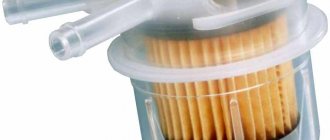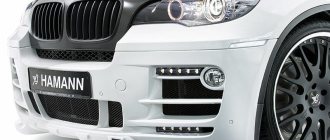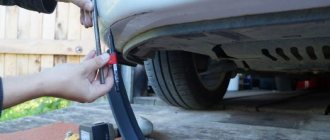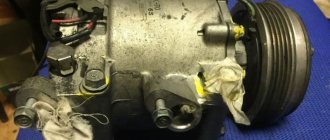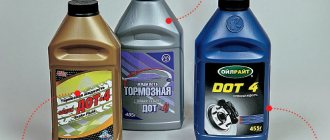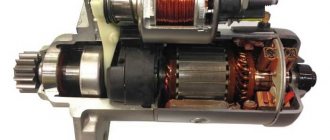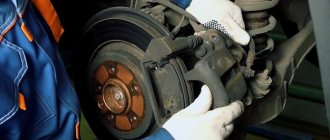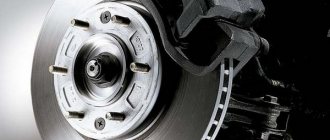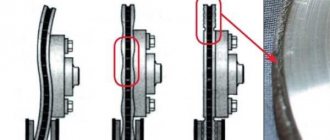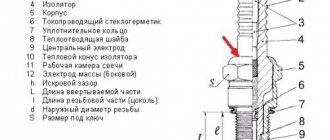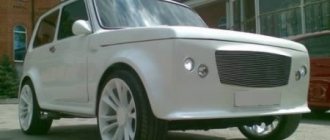The brake disc is the main element of the brake, to which the force of additional mechanisms is applied. Since automobile brakes use friction as their operating principle, a pad coated with friction material interacts with the disc. During operation, the disc heats up, which can lead to its deformation, disruption of the working surface, resulting in the disc beating, transmitted to the brake pedal. A conventional brake disc is made in one piece with a U-shaped hub. When braking, the disk tends to turn out due to the difference between the outer and inner contours. This causes the edges of the disc to lift and it loses working power.
When to change brake discs
There is no specific operating time or set mileage of the car in case of replacing the TD. And yet, many car enthusiasts face this problem. Signs of a faulty brake system are determined quite simply:
- squeaking around the wheels when you press the brakes;
- increased brake pedal travel, so-called sagging;
- a significant decrease in the fluid level in the main brake reservoir;
- When you press the brakes, the car pulls to the side or a vibration is felt.
What caused the appearance of such signs of malfunction in the vehicle is determined by a visual inspection of the condition of the mechanisms, in particular, the degree of wear of the brake discs and pads on all wheels is determined. Based on its results, a decision is made whether the brake pads need to be changed or whether the brake discs need to be replaced.
Pros and cons of different brake disc designs
Everyone has wondered what's so great about vented discs or what's the benefit of rotors with holes drilled into them? Let us explain everything...
We all know the basic function and working principle of disc brakes. The caliper pushes one or more pads against the rotor, causing friction and slowing down the rotation of the shaft to which the brake rotor is attached. But despite the fact that the operation of all braking systems is built on this single principle, the parts used to operate can vary significantly over time and depending on the use of the vehicle.
The material of the brake pads may vary, there are many types of calipers - some for road cars, others for sports cars, others for hypercars, and so on. Even the brake discs can be different.
So, the topic of today’s conversation will be the types and classification of brake discs, as well as their differences:
Preparing to replace the AP
Having determined that the TD is faulty, you need to prepare to change them yourself. To do this, you first need to buy a new spare part from a car store. When choosing brake discs for his car, the car owner must take into account his driving style. Does he like to accelerate sharply and actively maneuver? How often does he use the brakes? He drives a lot around the city or mostly intercity trips on the highway. The spare part from which manufacturer you need to buy depends on these factors. Discs can be standard or sports.
- Standard TD - made of cast iron, the casting is processed on a milling machine. They are ventilated and non-ventilated. Without ventilation, it is a single disc that is pressed on both sides by brake pads. A disk with ventilation is easy to distinguish - it is two disks connected by bulkheads. Ventilation occurs during movement due to air entering between these pancakes. Some of the respected manufacturers of these products are Bosh, Zimmerman, ATE.
- Sports TD - made of durable and ultra-strong gray cast iron, as well as austenitic stainless steel. These are considered to be more durable products that can last much longer and with more aggressive driving. Such discs are produced by EBC, DBA, Brembo.
The driver must remember that when the front brake discs are replaced, they must be changed in pairs, even if one of them is suitable for further use in all respects. The same rule applies to rear brakes.
This rule is explained by the fact that unequal weight of the same type of spare part on the wheels of the same axle will lead to loss of directional stability. Thus, for repairs, two or four TDs are purchased, but in no case one or three. In the garage or at a special technical site, the tools and materials necessary for repairs are prepared in advance.
- Jack and wheel wrench.
- Keys to "13" and "17".
- Ratchet wrench.
- Large flathead screwdriver.
- Thin flathead screwdriver.
- Clamp.
- A piece of wire to fix the stupor.
- Hammer.
- WD fluid to unscrew stuck fasteners.
- Brake fluid, in case of bleeding the brakes.
- Rags.
Place the machine in a hole or on a prepared level area. Decide in advance whether the rear brake discs need to be replaced or only the front ones need to be replaced. This determines how to jack up the car. Raise the entire side or just the front wheels. After raising the car with a jack, remove the wheel using a balloon. Clean the released brake mechanism and the surface of the hub from dirt and oil using a brush and rag.
Why do brake discs fail?
Brake discs bear a serious load: when braking, they are subject to a real thermal attack! Hence the risk of overheating, deformation and breakdown, which invariably lead to a shortened service life and the need for premature replacement. Therefore, increased demands are placed on quality and materials. Although, in fact, they all fit into two important criteria: strength and cooling ability - the disk must withstand repeated and sudden temperature changes and be well ventilated.
In addition to increased loads, brake discs can wear out quickly due to careless or illiterate operation. Aggressive driving, poor-quality road surfaces, the desire to save on maintenance - all this “plays” against the motorist. By limiting yourself to replacing only the discs and leaving the confidently “aged” pads, you risk soon getting rapid wear and the same need for replacement. This is why it is so important to assess the condition of all elements of the brake system and carry out their timely updating - pads and discs work in pairs, and their symbiosis is impossible if one of the “participants” is of inadequate quality.
Types of disc brakes
Disc brakes are divided into two large groups according to the type of caliper (caliper) used:
- mechanisms with a fixed bracket;
- mechanisms with floating bracket.
In the first version, the bracket can move along guides and has one piston. In the second case, the caliper is fixed and contains two pistons installed on opposite sides of the brake disc. Brake mechanisms with a fixed caliper are capable of creating greater pressing force between the pad and the disc and, accordingly, greater braking force. However, their cost is higher than that of brakes with a floating caliper. Therefore, these brake mechanisms are used mainly on powerful cars (using several pairs of pistons).
Types of brake discs?
So, it's time for a replacement. What to choose from the variety presented?
First of all, you need to consider the design features: are there ventilation holes, is perforation provided, is the disk made of one metal or composed of different...
Today, almost all brake discs are ventilated and, unlike non-ventilated ones , they consist of two plates, the cavity between which provides additional cooling. Regardless of the number of plates, the disks may or may not be perforated. In this case, through and buried perforations are distinguished (not through). The first cools well and removes working gases, but can negatively affect the reliability of the disk. The second also effectively copes with the removal of burnout products and at the same time contributes to the preservation of strength properties.
Disks are also classified into solid (made from a single piece of metal) and composite : the aluminum hub and cast iron ring are bolted together, which prevents spontaneous unwinding. Composite discs have high thermal and ventilation characteristics (due to the use of aluminum alloy), resistance to deformation, lighter weight and the possibility of partial replacement (for example, only the rings).
How a brake disc works and why it is better than a drum: let’s figure it out with Ferodo
A little history
The need for brakes appeared almost immediately after the invention of the wheel, but our ancestors a couple of thousand years ago did not rush things and rode chariots for a long time without brakes in our usual sense.
However, by the time carriages appeared, brakes had already matured: these were mechanisms that acted directly on the wheel. The block, pressed by a lever to the outer surface of the wheel, could not effectively stop a horse-drawn carriage, but it was quite capable of helping the horses. But then rubber tires were invented, and the mechanism that pressed the pad to the wheel was retired. At least in road transport: today mechanisms with external pressure work successfully on the railway, although there are plenty of alternatives there too. On ordinary roads, carriages acquired band brakes: the drum on the axle was stopped by a brake band pulled by a lever. However, the effectiveness of such a scheme was also quickly recognized as insufficient, so engineers continued to work on the invention of new mechanisms. The result of this work were two fundamental mechanisms that operate in cars to this day: the drum and disc brakes. They appeared almost simultaneously, at the very beginning of the 20th century, but at first drum mechanisms took the lead. It was not only the authority of Wilhelm Maybach, who installed drum brakes on the car he invented, and Louis Renault, who patented the design with semicircular pads. Drum brakes were simpler, and the development of friction materials helped popularize them. A key step in the development of friction materials was the creation of brake linings based on asbestos and phenol-formaldehyde resins, and this was done in 1902 by Ferodo. In general, the beginning of the century was truly the starting point in the development of braking systems.
However, it took time for disc mechanisms to catch up with drums and become popular. In the early stages they had more problems than advantages: there was no suitable material for the manufacture of discs, in the absence of amplifiers, a mechanical drive system required more force compared to a drum drive, and even a hydraulic drive did not solve the problem due to the lack of normal brake fluid. In general, there were more questions than answers, so at first the use of disc brakes was sporadic. One of the pioneers of their use was William Lanchester, but at that time he was not able to make disk mechanisms a competitive advantage of his machines. For example, on Lanchester cars at the beginning of the 20th century, due to the limited choice of materials, the wheels were bronze, which did not contribute to their wear resistance. However, the patent he received nevertheless stimulated not only himself to continue working on improving disc brakes.
The disk scheme received real development after another 25-30 years. By that time, the hydraulic drive had been worked out, and a vacuum booster was introduced to reduce the pedal effort to an acceptable level. True, in the 30s, the vacuum booster was mainly implemented on American cars with drum brakes, since they were still cheaper and easier to manufacture. However, the coming transition from drums to discs was already tangible and inevitable. True, in the consumer segment it was greatly delayed by the Second World War. In wartime, disc brakes, of course, also received attention, but they were used and improved on tanks and airplanes, and not on passenger cars. Well, after the war, at the turn of the 40s and 50s, such mechanisms began to appear for the first time on production cars.
Of course, the development of disc brakes was accompanied by improvements in design and materials. In addition to vacuum boosters and more efficient brake fluid that did not boil when braking, an important step was the transition to cast iron as a material for the manufacture of brake discs. Moreover, gray cast iron has become such an effective solution that it is still used today in the vast majority of cars. Cast iron, however, did not completely solve the old problems. If cooling was improved by casting ventilated brake discs, then corrosion, albeit external, remained a faithful companion of disc brakes. However, we will talk about corrosion later - but for now let’s move from ancient history to modern history and remember how the efficiency of disc brakes has increased in recent decades.
What determines the effectiveness of disc brakes?
After obtaining an almost ideal recipe of normal cast iron discs, high-quality pads and overheating-resistant brake fluid based on polyethylene glycol and its ethers, the development of disc brake systems went mainly along an extensive path. The transition to ventilated discs took place quickly, as cooling was one of the key objectives for improving brake performance. But then began the search for the ideal balance between the diameter of the brake disc, its design, the material of its manufacture and the design of the brake mechanism. After all, taking into account the fact that the cast iron disk is very durable, holds loads well and dissipates heat well, you can and should put good pressure on it. This is where multi-piston designs came into the picture. Everything here is also simple: if the basic brake mechanism with a floating caliper provides for the presence of only one piston, which presses on the disc and presses the pads against it on both sides, then increasing the number of pistons and, accordingly, the area of the pads allows increasing braking efficiency without significantly increasing the diameter of the pad itself. disk. And this condition is much more important than it might seem: after all, a cast iron disc weighs a lot, so increasing the efficiency of brakes solely by increasing the disc area is practically a dead end due to the unjustified increase in unsprung masses.
In the struggle for unsprung masses, not only multi-piston mechanisms were born, but also composite discs. After all, the brake disc actually consists of two parts: the rotor, on which the pads press, and the central part, which is attached to the hub. In this case, the work of creating braking force falls mainly on the rotor, and it is this that needs to be cooled. But you can and should save a kilogram or two on the material of the central part. This, in fact, is the essence of composite disks, in which the central part is made of a lighter material such as aluminum alloy, and the rotor, attached to it with screws or rivets, is made of traditional cast iron.
The next step here was to replace cast iron with lighter materials such as carbon fiber and ceramics. It would seem that this is a new breakthrough, because carbon-ceramic brakes can be made as large as desired due to their low mass, and their wear resistance and heat resistance only strengthen faith in progress. However, in practice it turned out that carbon composite wheels are good only under extreme loads, when operating temperatures exceed a thousand degrees. In civilian conditions, “cold” brakes work much less efficiently, and it is mainly this dependence of efficiency on temperature that limits their use on mass-produced vehicles.
Thus, the primary material of choice for consumer grade brake rotors remains ductile iron, with the primary focus on workmanship and cooling efficiency. In these conditions, production technologies become important: the quality of raw materials and castings, surface finishing, as well as a well-established bench and practical testing procedure for quality control. All this is available to large manufacturers of brake components with extensive experience and production history, such as Ferodo. It was Ferodo, as we remember, that more than a century ago gave impetus to the development of braking systems with its developments in the field of friction materials. Today, Ferodo products are part of the extensive range offered by Tenneco's DRiV division. The company produces a full line of brake components, including discs, pads, calipers, hydraulic cylinders and hoses, brake fluids and much more.
Now let's go back for a second to the corrosion we talked about above. For cast iron discs, oxidation is not an operational problem, but an aesthetic one: for a cast iron disc to be eaten away by rust, it will take more than a dozen years, but surface corrosion appears on it after just a few months, especially in an aggressive environment such as road chemicals. And Ferodo has a solution to this aesthetic problem: wheels with Coat+ technology, which have a zinc-aluminium galvanic coating to protect the wheel from corrosion. This technology reliably protects not only the hub part of the disc from corrosion, but also the internal cooling channels, ensuring the required efficiency of heat removal during braking. That is, the life of owners of beautiful cars who pay attention to detail and do not like visible external defects becomes a little easier: wheels with Coat+ technology retain their original appearance for many years - subject to proper use and, of course, care.
Conclusion
Finishing the conversation about brakes, they usually talk about their importance, that you cannot save on them, like on tires, and also that brakes are the main condition for safety. Good pads are not just those that don't squeak. Good discs are not just those that came out of the factory smooth and round, but those that are made of high-quality material, have effective cooling and, accordingly, do not deform during active use. Of course, even warped discs can be sharpened in some cases, but miracles usually don’t happen: if they go bad once, they will go bad a second time. We, of course, agree with these truisms, and therefore we talk not only about the theory, but also about the choice of quality products - such as Ferodo. If this brand is more than 120 years old and Ferodo specialists developed and produced brake system parts for carriages back in 1897, and are doing this now for modern cars, then they clearly understand brakes.
Repair or complete replacement of brake discs is carried out if:
- Disc deformation occurs, which manifests itself in the form of vibration and ineffective braking;
- Deep edges and grooves form throughout the brake disc;
- The thickness of the disk reaches a critical level of 1-3 mm (the measurement is made with a caliper; it is the working area that is measured, and not the outer edge);
- There are other damages that prevent effective braking.
- Brake disc crack.
- "Bead" formation.
- Uneven wear, the appearance of grooves, holes and depressions on the surface of the disc.
How to extend the service life of a TD?
- Driving style is the factor that most influences the service life of brake discs. If you like an aggressive driving style with sharp acceleration and the same braking, you should be prepared for the fact that the life of your wheels will be much shorter than usual.
- You should also consider the quality of the pads, which can also wear out the disc if incompatible.
- Driving through mud and puddles at high speeds also does not bode well; do not overheat the brake pads if it is rainy outside or there are large puddles.
- Buy only high-quality brake discs and pads and follow the recommendations above, only then can you avoid premature or uneven wear of brake discs and pads.
That's all for me, if you have any questions you can ask using the comment form. I also remind you that the best gratitude to the author is a repost of this article on social media. networks. We will be grateful if you tell your friends about our site using the corresponding buttons located below.
Disc brake device
The design of the disc brake is as follows:
- caliper (bracket);
- brake slave cylinder;
- brake pads;
- brake disk.
The caliper, which is a cast iron or aluminum body (in the form of a bracket), is mounted on the steering knuckle. The design of the caliper allows it to move along guides in a horizontal plane relative to the brake disc (in the case of a mechanism with a floating caliper). The caliper housing contains pistons, which press the brake pads against the disc when braking.
The brake working cylinder is made directly in the caliper body; inside it there is a piston with a sealing collar. To remove accumulated air when bleeding the brakes, a fitting is installed on the housing.
Brake pads, which are metal plates with attached friction linings, are installed in the caliper body on both sides of the brake disc.
The rotating brake disc is mounted on the wheel hub. The brake disc is attached to the hub using bolts.
How to choose a brake disc and not run into a fake?
Today, things have begun to be counterfeited to such an extent that it is practically not clear where the original part is and where the fake is, so remember one simple rule, spare parts should always be purchased in car stores (Not in some cooperatives where ordinary people trade, but specifically in a special auto store) and the larger it is, the better, even if you overpay a little in terms of money, you will still buy a good original item, because specialized auto stores generally do not sell counterfeit goods and be sure to check with the seller if there is guarantee for the purchased product, without a guarantee you even need to take it, in fact it’s just a recommendation to you from us, because as we said earlier, recently counterfeits have become so good that it’s no longer possible to tell where the original is where is the fake, well, make it a habit, never buy spare parts without boxes (They should all be packaged, and the box should contain a manufacturer’s certificate or something like that).
Brake discs VAZ
On most front-wheel drive VAZ cars, the rear brakes are drum brakes. Unfortunately, they are not as effective as disk ones. Therefore, some owners prefer to replace drum brakes with disc brakes. Now this is not particularly difficult. The advantages of disc brakes are that, in addition to being more efficient, they are easy to replace, and their wear can be observed visually without removing the wheels. You can use front brake discs of the VAZ 2110, VAZ 2108 (13 inches) and VAZ 2112 (14 inches) models. These discs are ventilated and will fit on the rear axle. It is worth clarifying that the front discs should be 1-2 inches larger than the rear ones in order to avoid “overbraking” the rear axle.
Operation of the pads
Those factors that influence the wear of brake discs also interact with the pads. On the front wheels they wear out faster than on the rear wheels, since the main load falls on the front of the car. In case of replacement, the pads are changed along the axes - on all front or rear wheels.
Uneven wear of the brake pads may be due to a malfunction of the working cylinders, and, accordingly, the different pressure they supply to the brakes. A difference in the thickness of the pad lining of 1.5-2 mm indicates a problem in the system.
We list the recognition methods that require replacing brake pads:
- Upon visual inspection. A friction lining thickness of 2-3 mm is considered insufficient.
- Mechanical method. The pads may have special metal plates, which, when the linings wear down to 2-2.5 mm, will come into contact with the disc and produce an unpleasant grinding noise.
- Electronic method. A wear sensor is installed on the brake pad, which, when it comes into contact with the disc, closes the circuit, and the indicator on the dashboard immediately lights up.
Let's look at the advantages of disc brakes:
- The operation of disc brakes is not hampered by the ingress of water or dirt;
- Disc brakes are not afraid of rising temperatures;
- They may have more efficient cooling;
- Small in size;
- They are light in weight;
- Disc brakes are easy to maintain.
The main disadvantages of disc-based brakes include their high cost and lower braking efficiency than their drum counterparts.
The brake disc is the main element of the brake, to which the force of additional mechanisms is applied. Since automobile brakes use friction as their operating principle, a pad coated with friction material interacts with the disc. During operation, the disc heats up, which can lead to its deformation, disruption of the working surface, resulting in the disc beating, transmitted to the brake pedal. A conventional brake disc is made in one piece with a U-shaped hub. When braking, the disk tends to turn out due to the difference between the outer and inner contours. This causes the edges of the disc to lift and it loses working power.
